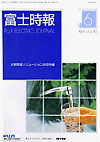FUJI ELECTRIC JOURNAL Vol.70-No.6 (Jun/1997)
 |
Solution Technologies Related to Water Quality |
Trends of Solution Technologies Related to Water Quality
Haruo Ito, Kiyoshi Kazama, Masakatsu Fukuda
The water environment has problems such as eutrophication in closed water areas, usual water shortages, and river water quality troubles. To solve these problems, Fuji Electric developed various sensors, treatment equipment, and application systems, and supplies these solution technologies, for example, toxicant detection systems for water quality troubles, high-sensitivity turbidimeters for cryptosporidia, and high-efficiency ozonizers. Fuji Electric will tackle the development and application of the detection of a surface-active agent, an oil film, and a colon bacillus supposed important in the water environment in future.
Water Quality Analyzers for Water and Sewage Treatment
Takashi Aoki, Yasuhiro Shinohara, Yasuo Takahashi
Water quality in water and sewage treatment becomes more and more important as the key to supplying safe, nice water and preserving the water environment. New treatment systems are applied to water treatment plants and the appointed tasks of water quality control and sensors become more serious. Fuji Electric developed characteristic water quality analyzers with new method in addition to conventional water quality analyzers and offers new management systems. This paper introduces water quality sensors for water and sewage treatment processes in association with process control.
River Water Management System and Supply Water Quality Monitor System
Hiroshi Tada, Tokio Ooto, Yoshiharu Tanaka,
Recently, many sudden troubles about river water quality have been caused. Fuji Electric has developed a continuous, high-sensitivity monitor sensor for river water quality deterioration due to a discharged harmful chemical substance and illegally abandoned water, and also a river water quality management system to support river management work against water quality troubles. In the field of water supply, it has started selling supply water monitor systems capable of measuring slight coloration more sensitively than with the eye. This system can automate water quality inspection on the consumer side and is much effective in avoiding an influence of turbid water in piping work.
Advanced Water Treatment and Process Control
Kazutaka Takahashi, Ryutaro Takahashi, Nobuyuki Motoyama
Recent quality deterioration of raw water such as offensive smell and usual water shortages has brought an increase in the amount of injected chlorine on. To meet a desire for safe and nice water and to reduce chlorine injection, it is required to develop advanced water treatment not only in metropolitan areas but also in local areas and to provide stable process control easy to operate. This paper introduces advanced treatment process control using ozone and activated charcoal, giving a concrete example.
Measurement and Control of Trihalomethane
Yasuo Nakahara, Souichirou Yamamoto, Kouji Kawakami
Trihalomethane is increasing though various measures has been taken for 16 years since it was used for the control target value in the circular notice of the Ministry of Health and Welfare and for four and a half years since it was added to the water quality standard, and so more tightened control for reduction is demanded. This paper describes changes in the water environment having trihalomethane increased, its generation mechanism, and present measures for reduction as well as the trihalomethane monitor system from the water intake to distribution using the trihalomethane meter capable of continuous measurement with the same sensitivity as gas chromatography and technique for reduction.
Sensor for Cryptosporidium
Yoshio Tanaka, Yoshio Saito, Dabide Yamaguchi
Cryptosporidium in the feces of domestic and wild animals flow into rivers with rainwater. Some of them pass through waterworks purification and are distributed with drinking water, resulting in infection. Recently, many raw water intakes for drinking water have been located at the downstream of rivers and there is much fear of mixing cryptosporidium in. This paper introduces cryptosporidium and measures against them according to the tentative guide of the Ministry of Health and Welfare and describes a high-sensitivity turbidimeter required by the measures and a control system that measures the diameter of microflocks and injects optimum coagulant.
Water Quality Management in Disasters
Masanori Morimoto, Ryoon Hasumoto
The importance of grasping the actual state of the disaster-stricken area was recognized again by the Hanshin Earthquake. This paper describes what water quality analyzers can be used and by what methods water quality data obtained can be surely transmitted, processed, and furnished as information to grasp the state of water quality in water and sewage treatment facilities when an earthquake and other disasters occur. As examples of measures against disasters, a standby system for a water purification facility and an emergency water supply system for disaster areas, including the role played by water quality analyzers in them, are introduced.
Spaceborne Cryocooler for Infrared Sensors
Futoshi Fujinami, Keishi Ohshima, Koichi Endoh,
The TIR cryocooler is used for cooling the TIR (thermal infrared radiometer) of the ASTER (advanced spaceborne thermal emission and refrection radiometer), developed by MITI/Japan Resources Observation System Organization. The requirements of the cryocooler included high performances such as a cooling capacity of 70K-1.2W, reliability not less than 0.97 after 80,000h, vibration force due to cooler operation not more than 0.1N, and power consumption not more than 55W. These requirements were attained by holding the opposite pistons driven by a voice coil motor in noncontack in the clearance seal with suspension springs. This paper describes the design concept of the TIR cryocooler and the result of verification tests.

